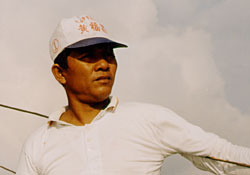Visit Bohol !
Wednesday, December 19, 2007
Nature's splendor abounds in the island of Bohol. It is famous for its Chocolate Hills, a group of uniformly shaped hills that turns brown during summer, and the many old Spanish churches. Despite the strong Spanish influence, the people have retained much of their local culture. The island's natural countryside blends well with the people's hospitality and simplicity. Bohol is proud of its beautiful white sand beaches and many interesting dive spots.
Visit us virtually in Bohol using Wikimapia using Google Maps technology. Here you can find already categorized places and commented for your convenience. Go now by clicking here.
Tuesday, September 12, 2006
Watching Dolphins on Bohol
IJsselstein, Thursday, 27 July 2006 03:13:46
Bohol, an island in the middle of the Visayas, the large group of islands in the middle of the Philippines, is an excellent tourist destination, as it has much to offer to visitor. Long stretches of white beach to laze around, world class diving spots with some of the best coral reefs in the country, the amazing and unique Chocolate Hills, which you will have to see to believe, the shy and tiny Tarsier, one of the smallest primates in the world, a rich
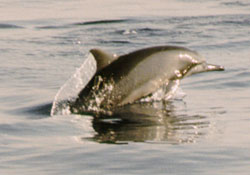 |
| A long-snouted spinner dolphin, Stenella longirostris. |
One of the attractions of Bohol is the ability to go dolphin and whale watching on the Bohol Sea. Joselino "Jojo" Baritua runs a project in which former whale-hunters can still use their whale and dolphin spotting skills to earn a living, but now to guide tourists to the best spots for a meeting with those gentle giants and playful jokers of the sea. After being in touch with Jojo for about a year about his dolphin and whale watching operation, we finally had the opportunity to meet him and join him on a small expedition of dolphin watching. We didn't go for whale watching, since we arrived in the wrong time of year. I invited my family-in-law to join the trip, because, although they live in Bohol, they have very little opportunity to see much of the natural beauty of the island. Even though Alona beach is just 50 kilometers from home, their are little opportunities to go there, let alone stay there.
We made an appointment to be picked up at Alona beach at six o'clock in the morning: for dolphin watching you've to wake up early, as they forage early in the morning, and their hunting grounds are quite some distance from the coast.
We woke up with excitement already at five o'clock. For all of us, it would be our first dolphin-watching trip, and we were full of expectation. Of
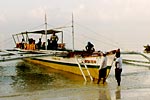 |
| The bancaLores. |
After we all were settled on board, we set off. First, the crew pushed the banca away from the beach with long bamboo poles, then they started the engine, and we got some speed. It is actually quite surprising how fast these bancas can go.
We headed eastwards, straight towards the dolphin's feeding ground. Already, Ben Guirigay, a former whale hunter and one of the best spotters from Pamilacan, who joined the dolphin and whale-watching program in September 1998, was standing on the lookout for the telltale signs of dolphins. After about
As we came closer to the spot, we started to see more and more dolphins. Groups of them popped up at the left and right, and more groups showed up at the horizon. The banca slowed down, and we found ourselves literally surrounded by dolphins, some jumping up and giving away a nice show of their acrobatic capabilities - if you ever wonder how they teach all those jumps and twirls in a dolphin show: they don't; dolphins are natural talents. The kind of dolphins we were watching now are aptly called "spinners" as they are capable of spinning around their own axis when they jump out of the water.
All this jumping and spinning is of course great fun, but also serves a purpose. The dolphins are actually hunting for fish. One group of dolphins chasing the fish, scaring them with all the noise they make, while others wait. We could see the fish jump out of the water in an attempt to escape their enemies, but only to land straight into the mouths of another dolphin, an interesting spectacle to observe.
Taking pictures of dolphins takes some patience and luck. Even when there are plenty, they jump out of the water unexpectedly, and disappear before you can even press the shutter. Most of they time you will end up with only their tails being captured on the film. You will need a good telescopic lens to be able to get some nice close ups.
We continued following the dolphins. By now, we saw groups of dolphins appear over a stretch of about two kilometers or more, maybe over 500 of them, a magnificent view, which we all enjoyed.
Not far from us was another banca, from one of the dive shops on Alona Beach, carrying a group of tourists also observing the spectacle - but then suddenly a third, smaller banca appeared. At first it was unclear what their business was, but then it became apparent that the people on board were actually trying to kill the dolphins. The crew on our banca looked angry and told us they were Badjau, and started to gesture angrily at the other banca. The skipper, Joseph Valeroso, himself a former hunter who had been behind bars for 5 days fined P 5,000.00 when the Lores was captured in 1999, started to chase them. They quickly went away. Unfortunately, I was not able to take a clear picture of their banca against the low standing sun.
This incident again demonstrates that a patrol boat is urgently needed to enforce the ban on hunting dolphins and other protected species in this area. Unfortunately, hardly any funds are available for such a patrol boat, and even if such a boat is donated, funds will be required for its maintenance and continuous operation, which will also cost considerable in wages and fuel.
After about three hours of dolphin watching, we set course for Pamilacan, a small island which is the home of fishermen, and our crew. On our way here, we come across yet more dolphins, this time the bottlenose dolphin. This species is somewhat larger and darker than the spinner dolphin, and is not able to
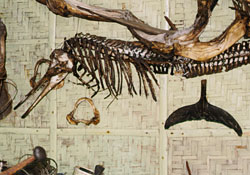 |
| A dolphin skeleton, dolphin tails and shark-jaws on display in the fish shop on Pamilacan island. |
On the north side of Pamilacan island stands an old Spanish watch tower. Build several centuries ago by the Spanish rulers to house a lookout against Moro marauders, it has now become a ruin, and is in dire need of some action to prevent further decay. Similar towers can be found in several places on Bohol, the most well known and best preserved is the tower at Punta Cruz, Maribojoc, and the tallest that of Panglao. We walk around the watchtower and
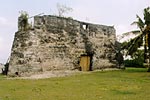 |
| The Spanish watchtower on Pamilacan Island. |
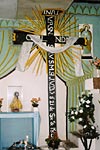 |
| Wooden cross; Pamilacan Island. |
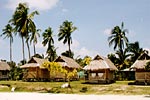 |
| The Resort on Pamilacan. |
The reef directly in front of the beach here has been extensively damaged by destructive fishing methods, such as dynamite fishing. Little away from the harbor, the reef is already considerably better, and to the east of the island, the reefs are on of the favorite destinations of the divers, who come here with large bancas from Alona beach.
After our snorkeling, we all board the banca again for our trip back to Alona beach, which we reach after about one hour, tired but happy with our inspiring meeting with the dolphins.
How to make your own Dolphin watching trip
To organize your own dolphin wathcing trip, contact ...
... is to go with a group, so that the cost of the boat can be shared. Dolphins can be spotted year-round, but you'll have the best change to spot a whale from March to May.
How to get to Bohol
Flights now connect Bohol with Manila daily, so you can now easily fly to Manila, then transfer to the domestic terminal for a connecting flight (1 or 2 hours, depending on aircraft type) to Tagbilaran. Alternatively, you can fly to Cebu (directly from abroad via Singapore, or via Manila), and then use a fast ferry (1.5 hours) to Tagbilaran. You can also take a flight from Cebu to Tagbilaran (half an hour), but given the time it takes to get to the airport, this hardly gains you anything, except some nice sights of Bohol from the air. From Tagbilaran, it is about 25 minutes to Alona Beach, and 15 to Baclayon.
Where to stay at Alona Beach
Alona beach has large number of resorts in various price-classes and quality. It is certainly worthwhile to check-out a few places and compare prices and facilities. At the low-end of the price range, Alonaville rents out simple, somewhat run-down, cottages with fan at about ...
... all in a lovely garden. You will certainly love the swimming-pool here, as it is set romantically in a natural hollow, connected to caves, some three to four meters below the surrounding garden. At the high end of the price range is, recently opened after over four years of construction, is Alona Palm Beach Resort. Here the luxury rooms go for P5500 / $110 per night. Each room is actually in a separate building, set in a nicely landscaped garden direct on the beach. The swimming pool is the largest on the beach, and boasts an edge with waterfall, such that, when you are swimming in it, it appears to be a continuation of the sea.
Jeroen Hellingman
Visit SiteTuesday, July 18, 2006
Where to Stay in Bohol
IJsselstein, Thursday, 27 April 2006 06:12:30
Bohol already has a large number of hotels, resorts, and other facilities for tourists. Most of these are concentrated in Tagbilaran and around Alona Beach, with a few more scattered around the island. To help you make your choice we have listed most hotels here, with some short personal comments.
Anda
Anda, a peaceful muncipality on a peninsula with the same name at the north-east of Bohol, about 100 kilometers from Tagbilaran (2 hours by bus), is so-far mostly unaffected by tourism, but this is likely to change once more people discover its wonderful beaches, and the attractive environment of the peninsula. So far, only a few resorts have openend their doors to visitors, but a few more are in development.
Bituon Beach Resort, under German and Filipino management is located on top of some very nice cliffs in Basdio, Guindulman. It consists of a number of nicely maintained bungalows in native style with a terrific sight across the Bohol Sea. The bungalows are provided with basic facilities, and are clean and spacious...
Cocowhite-Beach Resort, also in Basdio, but Swiss owned, opened its door on 4 May 2002. It has a small private beach, and includes all facilities for diving, including courses. The resort also is mainly oriented to German speaking guests...Dapdap Beach Resort, in Candabong, Anda, lies at the western end of Anda's stretch of wonderful beaches. Under Filipino management, this resort offers aircon rooms up to...
Flower-Beach Resort, in Virgen, Anda, provides airconditioned guestrooms in duplex houses. Build in traditional materials, but designed to western comfort standards...
Balicasag Island
Balicasag island is a small island south of Panglao island and belongs to the muncipality of Panglao. It is the home to a small barangay with the same name, two light-houses (an old, American build one, and a modern one build with British aid), and one resort. Around the island are some of the best diving spots in the Philippines. A world-class overhanging wall, going from about 7 to more than 60 meters deep, and some wonderful coral reefs that are worth the trip alone.
Balicasag Island Dive Resort has a number of okay cottages straight on the beach at the southern side of the island, and its own restaurant...
Cabilao Island
Cabilao Island is an island to the west of Bohol, part of the muncipality of Loon. Unlike the nearby islands of Sandingan and Pangangan it is not connected with the main land of Bohol, so you'll need to go there by boat, which is possible from Barangay Mocpoc in Loon. On the island are three resorts, and some of the best diving locations of the Philippines. The dive-site north-west of Cabilao Island is a favourite spot for shark enthousiasts, as hammerhead sharks can be seen here regularly. On the island itself, birds are protected, which means that you can see more of these feathered friends than you are used to on the main-land.
Probably the best value for money is Polaris Beach and Dive Resort, run by the German-Filipino couple Franz and and Maria Baumann. Franz is one of the few German resort owners who speaks fluent Cebuano, and is also active to build up the local community and preserve the islands natural beauty....
La Estrella Beach Resort, located directly at the sea, has a number of neat luxery bungalows in native style, a restaurant and a bar. The resorts is close to the Sea Explorers diving school, which has its own compressor, boats, and equipment to offer diving trips and...
The third resort on Cabilao is Cabilao Beach Club on the North-Eastern side of the island, close to the barangay Cambaquiz. Run under German-Swiss management...
Carmen
Carmen is a muncipality in the interior of the Bohol. It is the home of the world-famous Chocolate Hills, an amazing geological curiousity that can only be found on Bohol. The Chocolate Hills, which only turn to their characteristic brown colour that gives them their name at the end of the summer, consist of nearly two thousand highly regularly shaped hills, between 30 to 50 metres above a mainly flat land. It will take most people some time to accept that these hills are not man-made.If you would like to stay in the Chocolate Hills overnight, you have very little choice. The only facility is the Government run Chocolate Hills Resort. A couple of years ago, they started to extend and renovate the place, but, since funds have run out, work on this is suspended, and you'll have to deal with the mess of a half-completed resort...
Panglao Island
Panglao Island lies just opposite Tagbilaran city, and is connected with Bohol with two bridges. It consists of two muncipalities, Dauis in the north and Panglao in the south. The island is easy to reach and has a number of wonderful white beaches, which means that on this island most of Bohols hotels and resorts can be found. The larger part of these are concentrated around Alona Beach, a very nice stretch of white sand at the South-Eastern end of the island, but numerous are also spread along other parts of the island. If you arrive on Bohol without any reservation, it is probably best to go to Alona beach, and walk along a few of the hotels to find one that suits you and has place available. If you do so, don't forget to have a look at the places not directly at the beach, as they often have much better rooms to offer for less money. If you arrive late and plan to stay for a longer time, find an acceptable place for the night, and look for a good location the next morning -- often the bungalows or nipa huts somewhat away from the beach can be rented for weekly or monthly rates, which are much cheaper than staying straight on the beach.Dumaluan Beach, also on the eastern side of the island houses some of the more expensive resorts of the island, and along the other beaches are also a number of resorts, all listed here below.
Alona Kew White Beach Straight on the middle of Alona beach offers standard rooms starting from about...
Alona Palm Beach Resort, under Swiss management, is the most luxerious resort on Alona Beach. Opened in 2001, this resort is spaciously arranged in a nicely landscaped garden, directly bordering Alona Beach, but with care to keep some distance from the beach -- a good example of a nicely planned resort development. It consists of 12 luxerious villas, each good for two guest, and a main building with restaurant and facilities. ...
Blue Sky-Sea Resort Bolod
Bohol Beach Club Bolod, Tel. +63 38 411 5222, Fax: +63 38 411 5225
The Bohol Bee Farm is a very cozy and relaxing place on Panglao island. Owner and Chef Vicky Wallace prepares delicious meals from organically-grown vegetables on her farm--from squash muffins, vegetable lasagna to her specially-brewed coffee from roasted corn and wild berries. She rents her chalet-styled home to guests who want to enjoy the peace and serenity of having the entire farm to themselves...
Bohol Island Dive Resort Alona Beach, Tel. & Fax: +63 38 502 9005
Bohol Plaza Panglao Island, Dayo Hill, Mayacabac, Dauis, Bohol, Tel. +63 38 500 0882, Fax: +63 38 500 0970
Bohol Sea Resort Danao
Calypso Resort Danao, Cellphone +63 918 730 2902
Crystal Coast Resort Alona Beach, Tel. +63 38 502 9001, Fax: +63 38 411 3009
Dumaloan Beach Resort, Liboang, Tel. 5029081
Flower Garden Resort, run by two Swiss, Erwin and Hampi, who take turns in managing this nice little friendly resort. This place consists of three neatly designed houses and a duplex bungalow in a peaceful garden about 150 meters from the beach, just behind Alona Palm Beach Resort. The places are without airco, but include a fully equipped kitchen, so that you can do your own cooking -- very practical if you have special dietary wishes or want to save money if you are a long-term traveller....
Kalipayan Beach Resort, Alona Beach, Tel. +63 38 502 9037
Lost Horizon Beach Resort, Alona Beach, Tel. +63 38 502 9099, Fax: +63 38 232 4893
Oasis Resort Alona Beach, Tel. & Fax: +63 38 502 9083
Panglao Island Nature Resort Bingag, Tel. +63 38 411 2599, Fax: +63 38 411 5866
Peter's House, Alona Beach, Tel. +63 38 502 9056, Fax: +63 38 502 9107
Playa Blanca, Alona Beach, Tel. +63 38 502 9015
Rene's Place, Alona Beach, Tel. +63 38 502 9149
Sun Apartelle, run by the friendly German couple Irena and Boris Heberer, offers very neatly designed and well maintained apartments in a wonderful garden about 200 meters from Alona beach. All apartments are fully equipped with airconditioning, a large bed, bathroom, and kitchen imported from Germany, which means you can do your own cooking as you do at home -- but you don't have to, as they also have an excellent restaurant. The apartments are located in the garden, to which much care has been given. Some huge trees provide ample shade, and in the garden are a few cosy corners where you can retreat...
TGH Casa-Nova Garden, Alona Beach
Tierra Azul Alona Beach, Tel. +63 38 502 9065, email: tierraazul_beach@yahoo.com
Pamilacan Island
Pamilacan island is a small island half-way between Alona beach and the muncipality of Baclayon, of which it is a part. On the island is a small barangay with a church -- its cross is said to have washed ashore -- and an old triangular Spanish watchtower in a rather dipilated state. Eighty percent of the island is surrounded by a nice white beach, the remainder of the coast line is rocky. On the island is just one small resort, run by a local Filipino, who has constructed a number of small nipa huts almost on the beach. It lacks all except the most basic facilities, but is very peaceful -- without cars, motorbikes or jeepneys, the only sound you'll hear is that of the local poultry, and some fishermen with load motor-bankas. Including all meals, staying here will cost you 300 pesos per person. The owner will cook fish caught by the local fishermen. If you arrive here un-announced, you may wish to bring some food for yourself, as there is no shop on the island. This place was recently re-named Pueblo de Pamilacan.
To get there, you'll have to ask some of the inhabitants of Pamilacan to bring you there in a banka. They can be found on the pier of Baclayon, a 15 minute ride from Tagbilaran city.
Tagbilaran City
Tagbilaran City, the capital and main port of Bohol houses the main shops (including the department stores Bohol Quality and Plaza Marcela), banks with ATMs, money changers, and several attractions, such as the Bohol Museum and a few cinemas. However, unless you're here on business, during the fiesta or Sandugo festival, or arrive late or have to depart early in the next morning, there is little reason to stay here, as nicer places to stay can be found on Panglao. Still, the city has a good number of hotels and a few resorts.
Bohol Tropics Resort Club is one of the best known places on Bohol. Home to many official and semi-official functions, such as miss elections, it is the first place most Boholano's will point visitors too...
Casa Juana Lodging House, Carlos P. Garcia Avenue, Tel. +63 38 411 3331
Coralandia Resort, Graham Avenue, Tel. +63 38 411 3445
Tubigon
Tubigon, a friendly little town on the west coast of Bohol, is about 45 minutes by V-hire, or 90 minutes by bus from Tagbilaran City. It is also the place where boats from Cebu arrive. A fast boat gets you to Cebu in 45 minutes from here, and a slow boat cost about 60 pesos, so both the fastest and cheapest way to Bohol lead you through Tubigon. From here, you can also catch a direct V-hire to Carmen, for the famous Chocolate Hills. If pass through this place, don't forget to visit the church, which has some wonderful murals.
Apart from staying with locals, the only place you can stay here for the night is Ligayas Pension House, which has rooms starting at PHP 500 / USD 9 per night...
Jeroen Hellingman
Read MoreTuesday, July 11, 2006
Bohol Tourist Information
With its rolling hills and plateaus, crystal springs and beaches, Bohol is a picturesque island-province replete with ancestral homes and centuries old churches. Bohol is situated at the heart of Visayas. West of Bohol is Cebu, and to the east if Leyto. long its coastline are the numerous isles of Panglao, Pamilacan, Cabilao, jao, Mahanay and Lapinin, which are excellent dive spots.However, beneath the rustic charms of Bohol lies a thousand and one adventures just waiting to unfold. The site of the 1565 blood compact between Boholano chieftain Rajah Sikatuna and Spanish explorer Miguel Lopez de Leganzpi Bohol's historicity is evident in the province's relaxed, laid-back pace. Excavation in ancient burial grounds reveal artifacts dating back to China's Tang dynasy. Indeed, the province already had strong trading ties with the Chinese long before the Spaniards set foot in the country. Every year, the compact between the Muslim chief and the Spanish conqueror is celebrated through the Sandugo Festival in July. All year-round, the museums and churches attest to the province's rich heritage and culture. The Chocolate Hills is the most famous natural attraction to be found in Bohol. The province is home to the world's...
Tourist Attractions / Things to Do
Bohol Museum
Once the residence of the country's fourth president, Carlos P. Garcia, the Bohol Provincial Museum is Tagbilaran is a showcase of the...
Chocolate Hills
Consisting of 1,268 haycock hills with heights ranging from 40 to 120 meters, the Chocolate Hils is a wonder of nature. RIghtly so, the Hills are considered as ...
Heritage Tour
An early Spanish settlement, the province of Bohol is filled with old churches, tree-lined plazas and ancestral houses. Visit the Bohol Museum in Tagbilaran, the Punta Cruz Watch Tower in Maribojoc (a wooden cross supposedly bestowed with mysterious powers), the Baclayon Church, and the marker ...
Hiking and Cycling
Bohol's numerous hills, valleys and plateaus are ideal for hiking and cycling. In Bilar, a three-kilometer man-made forest is sanctuary...
Hinagdanan Cave
With its breath-taking symphony of stalactites and stalagmites jutting out of the earth, the Hinagdanan Cave is certainly a sight to behold. Bring a swimsuit if you want to swim...
Old Churches and Other Religious Institution
One of the earliest Spanish settlements, Bohol is home to one of the country's oldest stone churches, the Baclayon Church. Built by the Jesuits, Baclayon features a rich ...
River Safari
Go on an enchanting river tour. Bohol has four major rivers, Inabanga and Ipil in the north and Loboc and Abatan down south. From Busay Falls, cruise down...
Swimming and Diving
To top off this idyllic scenery, Bohol has also been blessed with pristine white-sand beaches and serene dive spots. Panglao Island has a number of beach resorts for...
Travel
Getting There
From Manila, take a Philippine Airlines plane to Cebu, then catch a connecting flight or a fast ferry to Tagliaran City, the capital of Bohol.
Getting Around
Bohol's moderate weather allows for long walks under friendly skies. As in most parts of the country, buses, jeepneys and tricycles are the main source of transportation. It's advisable to wear light clothing. And always, when you're hopping about, wear a smile.
Staying In
Bohol has a number of moderately-sized hotels and resorts to suit any tourist's needs. The Bohol Beach Club and the Alona Kew White Sand beach Cottages at Panglao Island offer rooms overlooking the island's white sand beaches.
Thursday, July 06, 2006
The Chocolate Hills
| IJsselstein, Sunday, 31 March 2002 05:33:17 The Chocolate Hills are probably Bohol's most famous tourist attraction. They look like giant mole hills, or as some say, women's breasts, and remind us of the hills in a small child's drawing. Most people who first see pictures of this landscape can hardly believe that these hills are not a man-made artifact. However, this idea is quickly abandoned, as the effort would surely surpass the construction of the pyramids in Egypts. The chocolate hills consist of are no less than 1268 hills (some claim this to be the exact number). They are very uniform in shape and mostly between 30 and 50 metres high. They are covered with grass, which, at the end of the dry season, turns chocolate brown. From this color, the hills derive their name. At other times, the hills are green, and the association may be a bit difficult to make... How to get therePlenty of tourist guides and tour operators will be happy to bring you to the chocolate hills, either as a separate trip or as part of a day tour. However, if you want to go here on your own, from Tagbilaran, you will have to go the integrated bus terminal in Dao and catch a bus going to Carmen. If you look like a stranger, you will have a hard time not finding one. At the entrance of the bus terminal people will point you to the right bus. Make sure it is the first one to leave, and ask the driver to drop you off at the... Where to stayIf you would like to stay in the Chocolate Hills, you have very little choice. The only facility is the Government run Chocolate Hills resort. Currently, this hotel is... Jeroen Hellingman Visit Site |
Wednesday, June 28, 2006
A trip to Bohol
by Stefan Kendrew
...Our next destination was Bohol, famous for the Chocolate Hills. We arrived there after a flight from Caticlan to Cebu, one night in Cebu, a boat ride to Tubigon and a bus ride from there to Carmen. We planned on checking out the Chocolate Hills, exploring the island a bit and staying for a few days at the Nuts Huts after which we would get some more time on the beach on Panglao.
Upon reaching Carmen (the town closest to the Chocolate Hills complex) we were surrounded by locals offering us a ride to the Chocolate Hills. We chose Victor (who is apparently mentioned in an old Lonely Planet) and two of his friends to take us there on the back of their dirt bikes, luggage and all.
Sure enough, the Chocolate Hills are everything they are made up to be: beautiful, eerie, nicest when the sun comes up and somewhat boring after a day or two. At the top of the tallest hill is a resort with a pool where the rooms have balconies looking over the Hills. The staff was bored out of their minds.
There is a tall staircase which brings you really high up, from where you get stunning views over the Chocolate Hills as the sun is coming up, lighting up the misty Hills with its rays.
We took a motorbike ride with Victor and his friends all over the surrounding area which was nice ...
Visit SiteTuesday, June 27, 2006
BOHOL
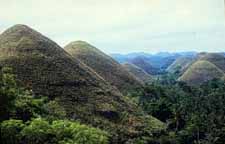 The island province lies southeast of Cebu in Central Philippines and is approximately one hour and fifty minutes from Manila. Apart from its world-famous Chocolate Hills as its attraction, Bohol's beauty lies in its unpolluted waters which are rated among the best diving havens in the world and being the home of the world's rarest shells such as the "Gloria maris" and the Golden Cowrie. The islands of Panglao, Balicasag and Pamilacan are superb diving spots of the province. In Panglao Island, a popular destination is the Hinagdanan Cave where you will find underground springs. Bohol is also the home of the tarsier, the big-eyed insect-eating monkey whose size is smaller than a boy's fist. Scientists regard the tarsier as the oldest mammal now inhabiting the earth.
The island province lies southeast of Cebu in Central Philippines and is approximately one hour and fifty minutes from Manila. Apart from its world-famous Chocolate Hills as its attraction, Bohol's beauty lies in its unpolluted waters which are rated among the best diving havens in the world and being the home of the world's rarest shells such as the "Gloria maris" and the Golden Cowrie. The islands of Panglao, Balicasag and Pamilacan are superb diving spots of the province. In Panglao Island, a popular destination is the Hinagdanan Cave where you will find underground springs. Bohol is also the home of the tarsier, the big-eyed insect-eating monkey whose size is smaller than a boy's fist. Scientists regard the tarsier as the oldest mammal now inhabiting the earth.
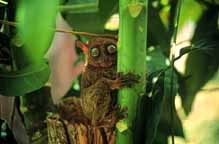
Visit Site
With its rolling hills and plateaus, crystal springs and beaches, the province of Bohol is a picturesque province replete with ancestral homes and centuries-old churches. The country's tenth largest island, Bohol is situated at the heart of Visayas. West of Bohol is Cebu, and to the east is Leyte. Along its coastline are the numerous isles of Panglao, Pamilacan, Cabilao, Jao, Mahanay and Lapinin, which are excellent dive spots.
However, beneath the rustic charms of Bohol lies a thousand and one adventures just waiting to unfold. The site of the 1565 blood compact between Rajah Sikatuna and Miguel Lopez de Legaspi, Bohol's historicity is evident in the province's relaxed, laid-back pace. Excavations in ancient burial grounds reveal artifacts dating back to China's Tang dynasty. Indeed, the province already had strong trading ties with the Chinese long before the Spanish set foot in the country. Every year, the compact between the Muslim chief and the Spanish conqueror is celebrated through the Sandugo Festival in June. All year-round, the province's museums and churches attest to the province's rich heritage and culture.
The Chocolate Hills is but one of the many natural wonders to be found in Bohol. The province is the home of the world's smallest monkey, the tarsier. The size of a fist, the tarsier lives on hills of Corella, some ten kilometers from Tagbilaran. Other exotic flora and fauna can be found amongst the ...

Bohol travel guide!
Bohol is a very nice place: excellent combination of culture, nature and people. It is easy to get around because you can rent vans or cars for a day and be able to visit several tourist destinations among them: Chocolate Hills, Baclayon Church and Museum, Loboc Church and Museum, lunch and river cruise at Loboc River, a place where you can see tarsiers and take photos with this wonderful creatures.
The drivers/owners of the vans/cars that we rented were very helpful in telling us about the places that we can go to. They were sensitive to cater to what kind of places that we wanted to go. They would even encourage you to go to many places as possible, and they were also very effective guides because they have information and side stories of the places the we visit. You can have a van rental - good for the whole day at ...
Visit Site
